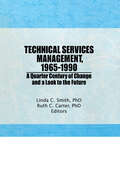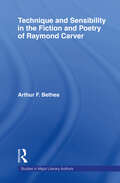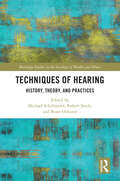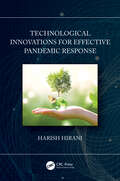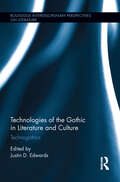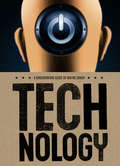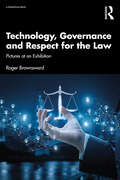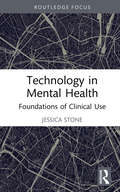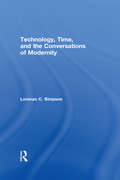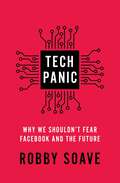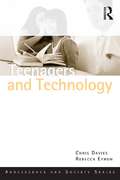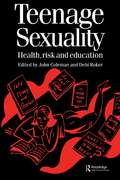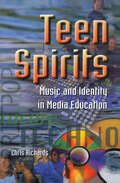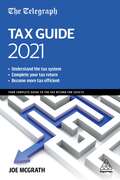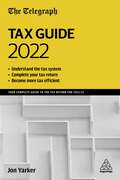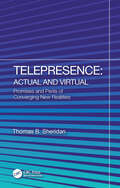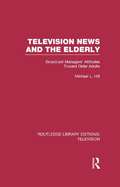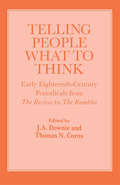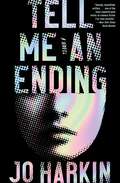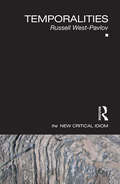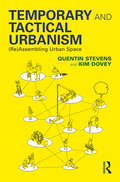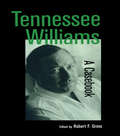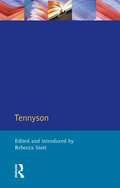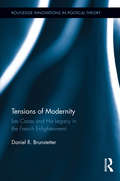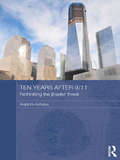Special Collections
Benetech’s Global Certified Accessible Titles
Description: Benetech’s GCA program is the first independent third-party EPUB certification to verify ebook accessibility. By creating content that is born accessible, publishers can meet the needs of all readers. Learn more: https://bornaccessible.benetech.org/
- Table View
- List View
Technical Services Management, 1965-1990
by Ruth C Carter and Linda C SmithGain an in-depth understanding of changes in technical services that have taken place over a quarter century and look at future trends and changes that may occur. Technical Services Management surveys and analyzes technical services in libraries from 1965 to 1990, a formative period and one of great change in library operations. The book also identifies trends that continue to impact technical services operations in libraries today. Readers gain a comprehensive knowledge of where the field has been and where it is now to help them plan and prepare more effectively for the future.Most chapters are historical, combined with a firm grasp of the present and a glimpse or more at the future. They are grouped to reflect the various aspects of technical services. Trends in technical services are considered in chapters on the development of technical services literature and the major changes in technical services in school libraries. Chapters on the major subdivisions within technical services--acquisitions and collection development, cataloging, and preservation--trace changes in library operations and the impact of automation. Issues in catalog design are explored in chapters on the emergence of online public access catalogs, bibliographic utilities, and approaches to authority control. Efforts to improve subject access are addressed through chapters on subject cataloging, the Dewey Decimal Classification, and indexing in the U.S. and Great Britain. To keep pace with changes in technical services, changes in professional education and development are needed as documented in chapters on cataloging education, continuing education in technical services, and the role of professional organizations. The final chapter outlines new challenges in the future and new roles for librarians in an electronic environment.Effective planning for the future includes learning about the past. Technical Services Management, 1965--1990 is a vital resource for library historians, library educators, technical services librarians, and graduate students in library and information science who need to know “how things were” in order to see more clearly “how things will be.”
Technique and Sensibility in the Fiction and Poetry of Raymond Carver
by Arthur F. BetheaA comprehensive examination of the fiction and poetry of Raymond Carver.
Techniques of Hearing
by Michael Schillmeier, Robert Stock, and Beate OchsnerHearing, health and technologies are entangled in multi-faceted ways. The edited volume addresses this complex relationship by arguing that modern hearing was and is increasingly linked to and mediated by technological innovations. By providing a set of original interdisciplinary investigations that sheds new light on the history, theory and practices of hearing techniques, it is able to explore the heterogeneous entanglements of sound, hearing practices, technologies and health issues. As the first book to bring together historians, scholars from media studies, social sciences, cultural studies, acoustics and neuroscientists, the volume discusses modern technologies and their decisive impact on how ‘normal’ hearing, enhanced and smart hearing as well as hearing impairment have been configured. It brings both new insights into the histories of hearing technologies as well as allowing us to better understand how enabling hearing technologies have currently been unfolding an increasingly hybrid ecology engaging smart hearing devices and offering stress-free hearing and acoustic wellbeing in novel auditory environments. The volume will be of interest to all scholars and students of disability studies, sound studies, sociology of health and illness, medical history, health and society as well as those interested in the practices and techniques of self-monitored and smart hearing.
Technological Innovations for Effective Pandemic Response
by Harish HiraniThis reference text discusses the potential of efficient R&D management during times of pandemic crisis and how it can provide time-bound real-life deliverables to ward-off the contamination-linked vulnerability aspects of social interaction. It discusses important topics including mechanical ventilator with oxygen enrichment, hospital waste management facility, hospital care assistive robotic devices, implementation of smart manufacturing, special purpose machines, micro machining, 3D printing, disposal of plastic waste utilizing high temperature plasma, automatic biomass briquetting plant, and fully automatic biodiesel plant. Features: Discusses novel technological innovations developed especially to effectively counter pandemics such as COVID 19. Explores how R&D modelling of technology can be interspersed with socio-economic values. Covers how innovative technological solutions can be developed as per the situational requisites and deployed in the least possible time to make maximum impact. Discusses industrial manufacturing and automation techniques. The text will be useful for graduate students, and academic researchers working in diverse areas such as mechanical engineering, industrial engineering, production engineering, manufacturing science, and automobile engineering. It covers influences of Pandemics on water and sanitation services, floating capsule-based biofilm reactor (FCBBR) methodology, and innovative segregation of waste through a mechanized model.
Technologies of the Gothic in Literature and Culture
by Justin D. EdwardsThis volume, a collection with contributions from some of the major scholars of the Gothic in literature and culture, reflects on how recent Gothic studies have foregrounded a plethora of technologies associated with Gothic literary and cultural production. The engaging essays look into the links between technologies and the proliferation of the Gothic seen in an excess of Gothic texts and tropes: Frankensteinesque experiments, the manufacture of synthetic (true?) blood, Moreauesque hybrids, the power of the Borg, Dr Jekyll’s chemical experimentations, the machinery of Steampunk, or the corporeal modifications of Edward Scissorhands. Further, they explore how techno-science has contributed to the proliferation of the Gothic: Gothic in social media, digital technologies, the on-line gaming and virtual Goth/ic communities, the special effects of Gothic-horror cinema. Contributors address how Gothic technologies have, in a general sense, produced and perpetuated ideologies and influenced the politics of cultural practice, asking significant questions: How has the technology of the Gothic contributed to the writing of self and other? How have Gothic technologies been gendered, sexualized, encrypted, coded or de-coded? How has the Gothic manifested itself in new technologies across diverse geographical locations? This volume explores how Gothic technologies textualize identities and construct communities within a complex network of power relations in local, national, transnational, and global contexts. It will be of interest to scholars of the literary Gothic, extending beyond to include fascinating interventions into the areas of cultural studies, popular culture, science fiction, film, and TV.
Technology
by Wayne GradyA sweeping history of technology’s advance that raises the crucial question of whether we are in control of technology, or whether technology controls us. An excellent introduction to technology for young adults.There is no doubt that we have come to rely on technology, not only for our comfort and convenience, but for our very survival as a species. A hundred and fifty years ago, Charles Darwin noted wryly that if the human species were returned to the wild without the advantage of technology, we would become extinct in six weeks.Since that time, technology has proliferated to the extent that we can no longer conceive of life without it. As this book shows, technology is more than the sum of the tools we use, whether they are primitive ploughs or space shuttles. It is a way of seeing the world, the way we determine how the world works -- technology is a way of thinking.We see this in the way technology has invaded our language: we speak of the education system, the cultural industry. Since the 18th century, we have tended to describe the universe as a giant clockwork, the body as a machine, and, more recently, the mind as a computer. These are all aspects of the degree to which we have come to live in a technological age."[The Groundwork Guides] are excellent books, mandatory for school libraries and the increasing body of young people prepared to take ownership of the situations and problems previous generations have left them." — Globe and Mail
Technology, Governance and Respect for the Law
by Roger BrownswordIn the context of the technological disruption of law and, in particular, the prospect of governance by machines, this book reconsiders the demand that we should respect the law, simply because it is the law. What does ‘the law’ need to look like to justify our respect? Responding to this question, the book takes the form of a dialectic between, on the one side, the promise of the prospectus for law and, on the other, the discontent provoked by the performance of law in practice; this is followed by a synthesis. Four pictures of law are considered: two are traditional pictures – law as order and law as just order; and two are prompted by the technological disruption of law – law as governance by machines and law as self-governance by humans. These pictures are tested in five performance areas: contract law, criminal law, biolaw, information law, and constitutional law. The synthesis, revealing the complexity of the demand for respect, highlights three particular points. First, the only prospectus for law that clearly commands respect is one that is committed to protecting the global commons (the preconditions for humans to form their own communities with their own forms of governance); second, any form of governance by humans will invite reservations and push-back against the demand for respect; and, third, governance by machines is not so much a superior form of governance as a radically different form in which questions about respect are redundant. This book will appeal to scholars and students with interests in the broad and burgeoning field of law, regulation and technology, as well as to legal theorists, practitioners, and others interested in the impact of new technology on law.
Technology in Mental Health
by Jessica StoneTechnology in Mental Health focuses on the responsible integration of technology into therapy in a world affected by COVID. Author Jessica Stone discusses the pandemic’s effects on the mental health field, historical fundamentals, and possible future implications. Chapters also explore legal and ethical considerations as well as educational and supervision needs. Seasoned and new clinicians alike will find valuable information in these pages as they progress from traditional to modern to post-COVID mental health treatment.
Technology, Time, and the Conversations of Modernity
by Lorenzo C. SimpsonTechnology, Time, and the Conversations of Modernity takes as its impetus the idea that technology is an embodiment of our uneasiness with finitude. Lorenzo Simpson argues that technology has succeeded in granting our wish to domesticate time. He shows how this attitude affects our understanding of the meaning of action and our ability to discern meaning in our lives.
Tech Panic
by Robby SoaveFrom award-winning journalist and author of the &“methodical, earnest, and insightful&” (The Guardian) Panic Attack, an examination of recent kneejerk calls to regulate Big Tech from both sides of the aisle.Not so long ago, we embraced social media as a life-changing opportunity to connect with friends and family all across the globe. Today, the pendulum of public opinion is swinging in the opposite direction as Facebook, Twitter, Google, YouTube, and similar sites are being accused of corrupting our democracy, spreading disinformation, and fanning the flames of hatred. We once marveled at the revolutionary convenience of ordering items online and having them show up on our doorsteps, sometimes overnight. Now we fret about Amazon outsourcing our jobs overseas, or building robots to do them for us. Here, with insightful analysis and in-depth research, Robby Soave explores some of the biggest issues animating both the right and the left: bias, censorship, disinformation, privacy, screen addiction, crime, and more. Far from polemical, Tech Panic is grounded in interviews with insiders at companies like Facebook and Twitter, as well as expert analysis by both tech boosters and skeptics—from Mark Zuckerberg to Josh Hawley. Readers will learn not just about the consequences of Big Tech, but also the consequences of altering the ecosystem that allowed tech to get big. Offering a fresh and crucial perspective on one of the biggest influences of the 21st century, Robby Soave seeks to stand athwart history and yell, Wait, are we sure we really want to do this?
Teenagers and Technology
by Chris Davies and Rebecca EynonThe popular media often presents a negative picture of young people and technology. From addiction to gaming, the distractions of the Internet, to the risks of social networking, the downsides of new technology in the lives of teenagers are often over-blown. Teenagers and Technology presents a balanced picture of the part played by technology in the lives of young people. Drawing on extensive interviews conducted over several years, this book offers a timely and non-sensational exploration of teenagers’ experiences and opinions about the digital technologies they use, desire and dislike. The book covers a range of topical subjects including: Social networking and online engagement in the wider social world Building online self-identity and group membership Technology in the home Developing technology skills in support of learning Drawing on technological resources in the journey towards adulthood. Grounded in what young people actually say about using new technology in their daily lives, Teenagers and Technology presents a picture in which young people have in some respects a unique relationship to technology, but one that is actually not exceptional or of a completely different order to how people in general relate to it. By providing a nuanced view on the topic, Teenagers and Technology counters the extreme accounts of ‘digital youth’, and exaggerated anxieties created by the mass media. It will be of interest to students and academics working in the fields of adolescent and Internet studies, along with education professionals, practitioners, teenagers and their parents.
Teenage Sexuality
by RokerFirst published in 1998. Routledge is an imprint of Taylor & Francis, an informa company.
Teen Spirits
by Chris Richards and Dr Chris RichardsRelating to both the practice of teaching media studies and also to theoretical questions within media and cultural studies, this study examines pop music, media studies and the micro-cultural politics of adolescence. It argues that media education has neglected pop music, and that, as something of enormous significance in the lives of young people, it merits a serious place in the field.; The author provides accounts of media studies in action, including detailed accounts of classroom discussions, interviews with students and teachers, examples of students' work and their biographical reflections. He links this to broader debates both within cultural studies and around the place of pop music in young people's lives.; "Teen Spirits" should be of interest to students of media and cultural studies, as well as to practicing teachers, and readers with an interest in questions of youth and identity.
The Telegraph Tax Guide 2021
by Joe McGrathThe Telegraph Tax Guide is the UK's bestselling tax handbook, containing everything you need to know about completing a self-assessment tax return for the 2020/21 financial year. With advice on how to complete self-assessment tax returns and a number of tax saving tips, this book includes: - Key changes from the Budget and Treasury Statements - How furlough will have affected how much tax you pay - Dealing effectively with HM Revenue and Customs - Worked illustrations showing you how to complete your tax submission - How living or working abroad affects the tax that you pay - Tax saving tips which help you save money - Inheritance tax and potentially exempt transfers Whether you are self-employed, work part time or full time, are unemployed or retired, if you pay tax The Daily Telegraph Tax Guide is invaluable. It helps ensure that you are as tax efficient as possible, offering practical advice, timetables and examples that make the complex and challenging world of tax returns easier to understand.
The Telegraph Tax Guide 2022
by Jon YarkerThe Telegraph Tax Guide is the UK's bestselling tax handbook, containing everything you need to know about completing a self-assessment tax return for the 2021/22 financial year. With advice on how to complete self-assessment tax returns and a number of tax saving tips, this indispensable book includes: - Key changes from the Budget and Treasury Statements - Dealing effectively with HR Revenue and Customs - Worked illustrations showing you how to complete your tax submission - How living or working abroad affects the tax that you pay - Tax saving tips which help you save moneyWhether you are self-employed, work part time of full time, are unemployed or retired, if you pay tax The Telegraph Tax Guide is invaluable. It helps ensure that you are as tax efficient as possible, offering practical advice, timetables and examples that make the complex and challenging world of tax returns easier to understand.
Telepresence
by Thomas B. SheridanTelepresence: Actual and Virtual explores the history of telepresence from the 1948 developments of master–slave manipulation, through to current telepresence technology used in space, undersea, surgery and telemedicine, operations in nuclear and other hazardous environments, policing and surveillance, agriculture, construction, mining, warehousing, education, amusement, social media, and other contexts. It also describes the various operator hand and body controls and the corresponding telerobotic actuation of robotic hands, arms, and locomotion. This book reviews the sensing and control technology, its history and likely future, and discusses the many research and policy issues that are raised. The book also takes up key questions relating to social and ethical issues, given that a person’s mechanical reach is becoming unlimited, enabling one to perform mischievous or harmful acts without identification, and what that portends for future developments in telepresence, including regulation and recommended directions of development. The primary audience for this book is professionals interested in human–robot interaction, human factors engineering, virtual reality, applications to space and undersea exploration, telemedicine and telesurgery, firefighting, mechanized agriculture, policing, drone surveillance, warehouse parts' fetching, mining, and military operations.
Television News and the Elderly
by Michael L. HiltThis concise survey investigates the television general managers’ and news directors’ attitudes towards the elderly in the United States. Originally published in 1997, it raises important issues of ageing in relation to the media with specific focus on the older viewer’s status as a viewing audience of the news and how they are presented in the news. This is still useful food for thought for gerontologists, mass communication researchers, social psychologists and media studies researchers.
Telling People What to Think
by Thomas N. Corns and J. A. DownieThis collection of essays displays a number of different approaches to the most significant early eighteenth-century periodicals. The range is considerable: the critique of ideology and polemical strategy, the political history of the press, the rhetoric of the genre, and the material circumstances of periodical production all find a place. The periodical profoundly shaped the English reading public's ways of perceiving the social and political institutions of their own age.
Tell Me an Ending
by Jo HarkinNamed a Best Science Fiction Book by The New York Times &“Sharply, beautifully written.&” —The New York Times Book Review &“Intriguing, frightening, witty, and humane.&” —The Wall Street Journal Black Mirror meets Severence in this thrilling speculative novel about a tech company that deletes unwanted memories, the consequences for those forced to deal with what they tried to forget, and the doctor who seeks to protect her patients from further harm.What if you didn&’t have to live with your worst memories? Across the world, thousands of people are shocked by a notification that they once chose to have a memory removed. Now they are being given an opportunity to get that memory back. Four individuals are filled with new doubts, grappling with the unexpected question of whether to remember unknown events, or to leave them buried forever. Finn, an Irish architect living in the Arizona desert, begins to suspect his charming wife of having an affair. Mei, a troubled grad school dropout in Kuala Lumpur, wonders why she remembers a city she has never visited. William, a former police inspector in England, struggles with PTSD, the breakdown of his marriage, and his own secret family history. Oscar, a handsome young man with almost no memories at all, travels the world in a constant state of fear. Into these characters&’ lives comes Noor, a psychologist working at the Nepenthe memory removal clinic in London. The process of reinstating patients&’ memories begins to shake the moral foundations of her world. As she delves deeper into how the program works, she will have to risk everything to uncover the cost of this miraculous technology. A provocative exploration of secrets, grief, and identity—of the stories we tell ourselves—Tell Me an Ending is &“an intellectually and emotionally satisfying thriller&” (Booklist).
Temporalities
by Russell West-PavlovTemporalities presents a concise critical introduction to the treatment of time throughout literature. Time and its passage represent one of the oldest and most complex philosophical subjects in art of all forms, and Russell West-Pavlov explains and interrogates the most important theories of temporality across a range of disciplines. The author explores temporality's relationship with a diverse range of related concepts, including: historiography psychology gender economics postmodernism postcolonialism Russell West-Pavlov examines time as a crucial part of the critical theories of Newton, Freud, Ricoeur, Benjamin, and explores the treatment of time in a broad range of texts, ranging from the writings of St. Augustine and Sterne’s Tristram Shandy, to Woolf’s Mrs Dalloway and Stoppard’s Rosencrantz and Guildenstern are Dead. This comprehensive and accessible guide establishes temporality as an essential theme within literary and cultural studies today.
Temporary and Tactical Urbanism
by Kim Dovey and Quentin StevensTemporary and Tactical Urbanism examines a key set of urban design strategies that have emerged in the twenty-first century. Such projects range from guerrilla gardens and bike lanes to more formalised temporary beaches and swimming pools, parklets, pop-up plazas and buildings and container towns. These practices enable diverse forms of economic, social and artistic life that are usually repressed by the fixities of urban form and its management. This book takes a thematic approach to explore what the scope of this practice is, and understand why it has risen to prominence, how it works, who is involved, and what its implications are for the future of city design and planning. It critically examines the material, social, economic and political complexities that surround and enable these small, ephemeral urban interventions. It identifies their short-term and long-term implications for urban intensity, diversity, creativity and adaptability. The book's insights into temporary and tactical urbanism have particular relevance in the context of the COVID-19 pandemic, which has highlighted both the need and the possibility of quickly transforming urban spaces worldwide. They also reveal significant lessons for the long-term planning and design of buildings, landscapes and cities.
Tennessee Williams
by Robert F. GrossTennessee Williams' plays are performed around the world, and are staples of the standard American repertory. His famous portrayals of women engage feminist critics, and as America's leading gay playwright from the repressive postwar period, through Stonewall, to the growth of gay liberation, he represents an important and controversial figure for queer theorists. Gross and his contributors have included all of his plays, a chronology, introduction and bibliography.
Tennyson
by Rebecca StottAlternative approaches have emerged which have radically altered our understanding of Tennyson's poetry and his relationship to the Victorian age. This text covers the most significant areas of new work on Tennyson, effectively linking feminist and gender studies with deconstructive, psychoanalytic and linguistic attention. The Introduction discusses ways in which orthodox critical approaches have dominated readings of Tennyson's poetry and provides a critical overview of the radical reappraisal of his work. It also provides a guide to the varied ways in which these new debates have shaped and are shaping themselves, with a final discussion of the future directions which Tennyson criticism is likely to take. The essays chosen cover and reflect a range of modes of critical enquiry compelling in themselves.
Tensions of Modernity
by Daniel R. BrunstetterPolitics today is marked by tension between claims of universal human rights and diversity. From the war on terror to immigration, one of the major challenges facing liberalism is to understand the scope of equality in a world in which certain peoples are perceived to reject and/or violently resist democratic principles. This book revisits Europe’s initial encounter with the Native Americans of the New World to shed light on how the West’s initial defense of so-called ‘barbarians’ has influenced the way we think about diversity today, and elucidate the arguments of exclusion that unconsciously permeate the moral world we live in. In doing so, Daniel R. Brunstetter traces Bartolomé de Las Casas’s oft heralded defense of the Native Americans in the sixteenth century through the French Enlightenment. While this defense has been rightly lauded as an early example of human rights discourse, tracing Las Casas’s arguments into the eighteenth century shows how his view of equality enabled arguments legitimizing the annihilation by ‘just’ war of those perceived to be ‘barbarians’. This philosophical narrative can be useful when thinking about concepts such as just war, multiculturalism, and immigration, or any area in which politics confronts radical difference.
Ten Years After 9/11 - Rethinking the Jihadist Threat
by Arabinda AcharyaTen years after the 9/11 attacks this book reassesses the effectiveness of the "War on Terror", considers how al-Qaeda and other jihadist movements are faring, explores the impact of wider developments in the Islamic world such as the Arab Spring, and discusses whether all this suggests that a new approach to containing international, especially jihadist, terrorism is needed. Among the book’s many richly argued conclusions are that the "War on Terror" and the invasions of Afghanistan and Iraq have brutalised the United States; that the jihadist threat is not one, but rather a wide range of separate, unconnected struggles; and that al-Qaeda’s ideology contains the seeds of its own destruction, in that although many Muslims are content to see the United States worsted, they do not approve of al-Qaeda’s violence and are not taken in by the jihadists’ empty promises of utopia.
